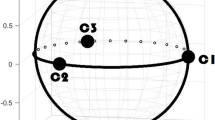Abstract
This is an analysis of the features of the new coordinate system given by the principal axes of inertia, as determined by Euler angles, and twodistances related to the inertia principal moments and an auxiliar angleas coordinates, for studying the general three-body problem, interactingthrough gravitational forces.
The reduction of order is performed in these new coordinates by using the angular velocity vector or the Euler angles.
The Eulerian case of collinear motion is revisited from our own perspective.
The value of the auxiliar angle is computed for the Sun–Earth–Moon system.
Similar content being viewed by others
References
Boccaletti, B. and Pucacco, G.: 1996, Theory of Orbits, Springer-Verlag, Vol. I.
Goldstein, S.: 1980, Classical Mechanics, Addison Wesley.
Marchal, C.: 1990, The Three-Body Problem, Elsevier, Amsterdam.
Piña, E.: 1999, A new solution to the Lagrange's case of the Three-Body Problem. Celest. Mech. & Dyn. Astr. 74, 163–174.
Whittaker, E. T.: 1965, Analytical Dynamics of Particles and Rigid Bodies, Cambridge University Press, Cambridge.
Author information
Authors and Affiliations
Rights and permissions
About this article
Cite this article
Piña, E., Jiménez-Lara, L. Properties of New Coordinates for the General Three-Body Problem. Celestial Mechanics and Dynamical Astronomy 82, 1–18 (2002). https://doi.org/10.1023/A:1013865801564
Issue Date:
DOI: https://doi.org/10.1023/A:1013865801564



